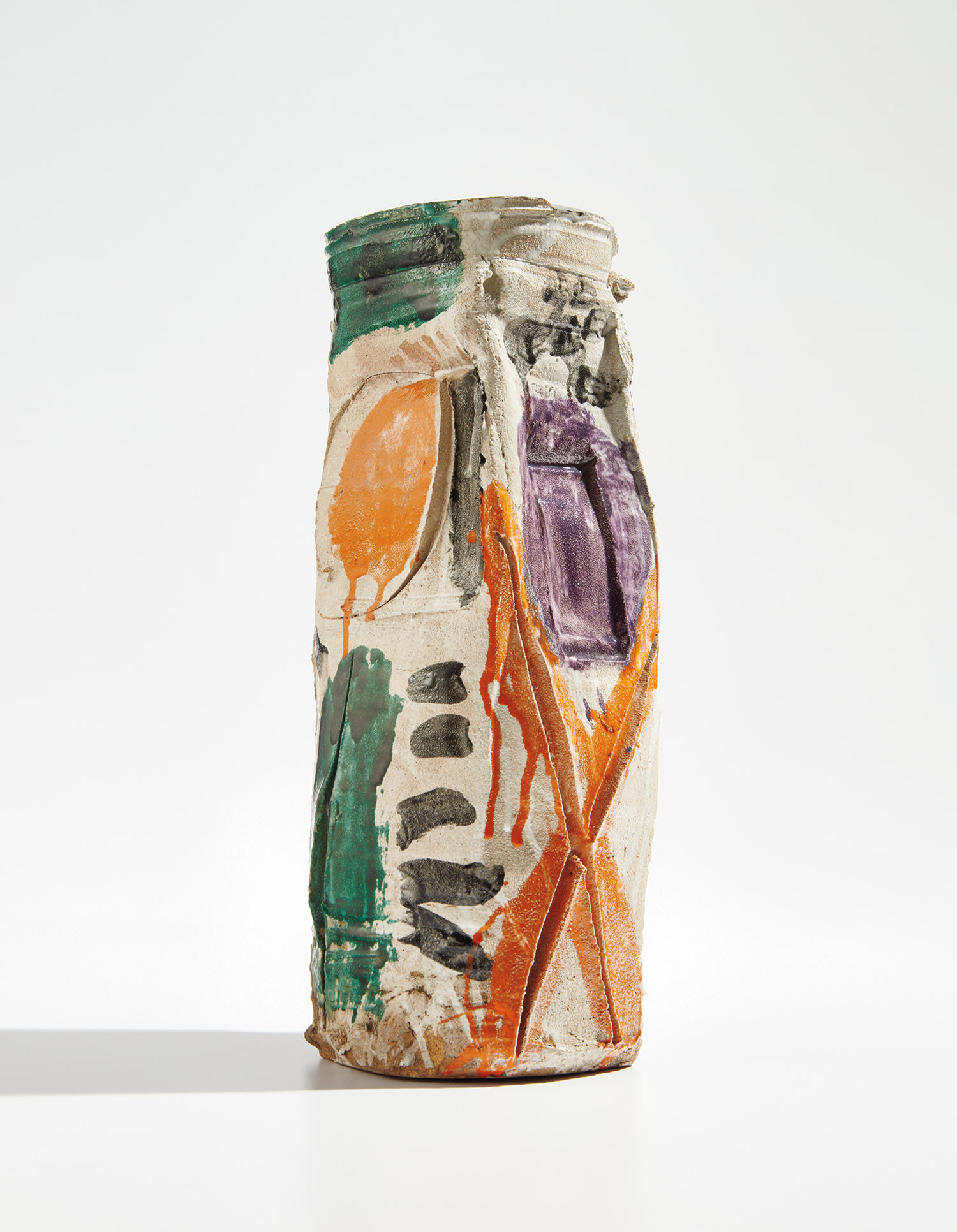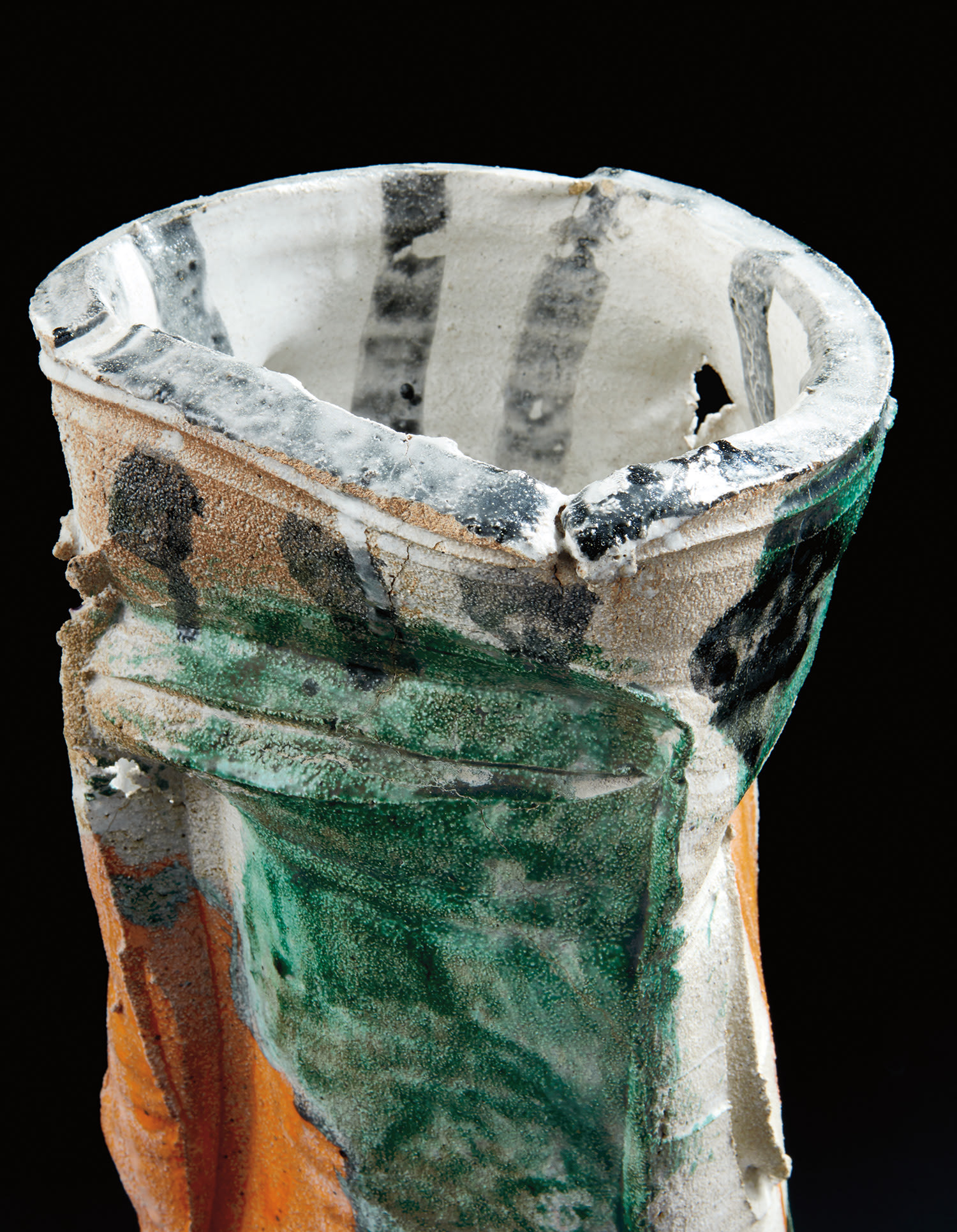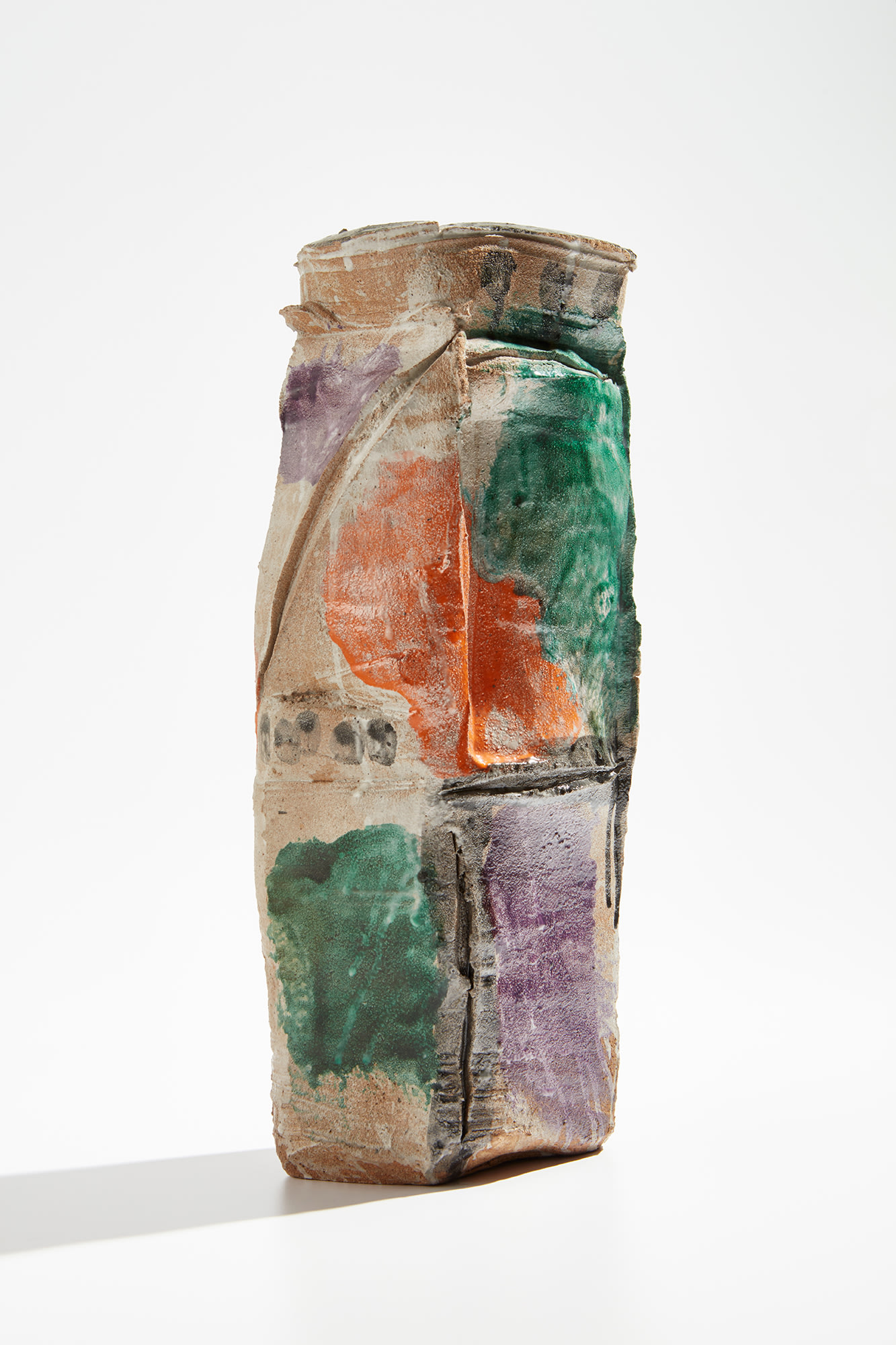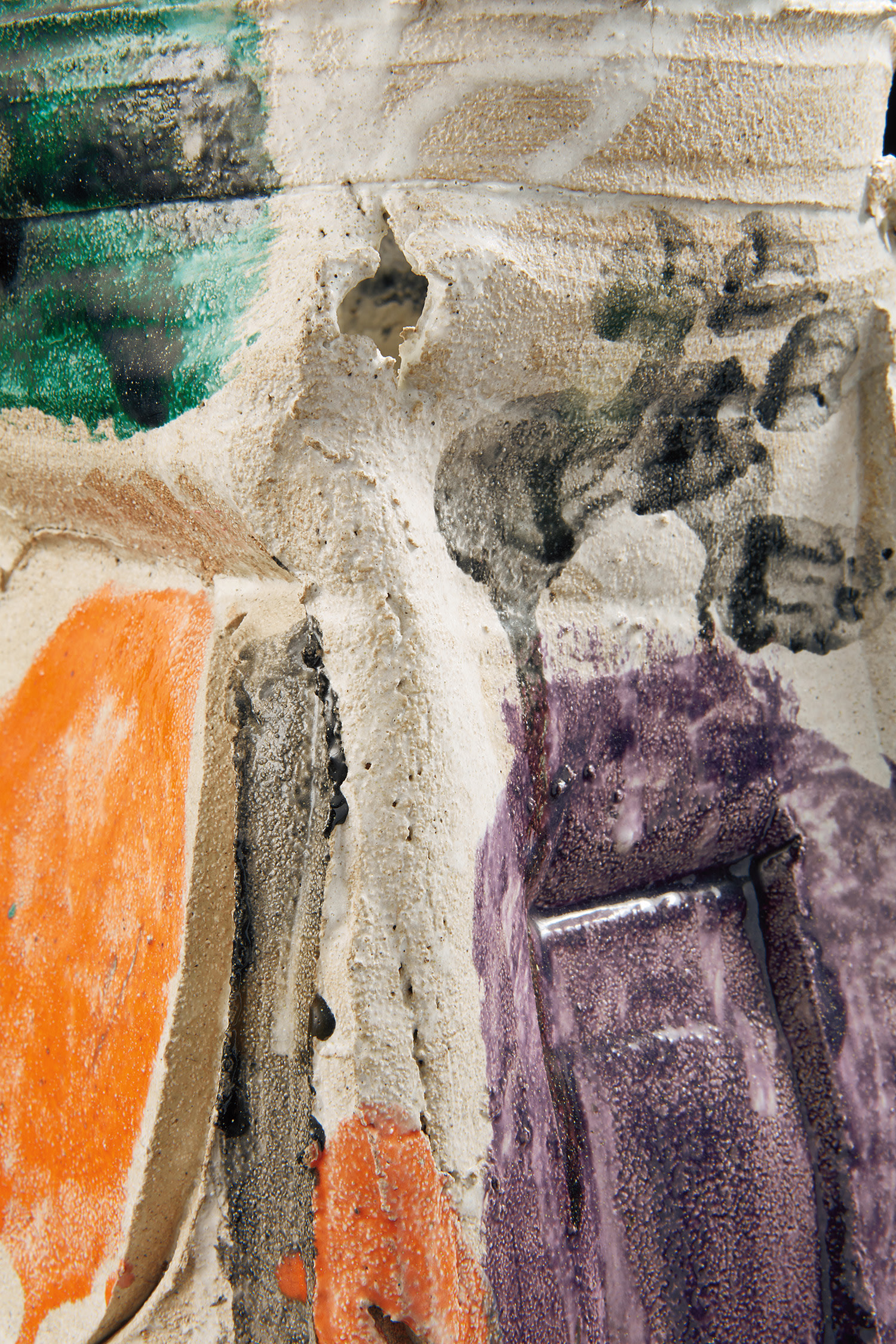







Property from a Private Collection, Los Angeles
67
Peter Voulkos
Untitled vase
signed in iron oxide 'Voulkos/59' on the underside
glazed stoneware
height 50.8 cm (20 in.)
Executed in 1959.
Full-Cataloguing
Slash and Burn
Peter Voulkos loved a crowd. Surrounded by admirers from the time he began teaching at the Otis College of Art and Design in Los Angeles in 1954, he seemed to thrive as the center of attention, whether he was playing guitar, talking about art, or – especially – working with clay. A gifted thrower and an adroit improviser, he captivated and surprised his audience, first creating large cylinders and then manipulating them at high speed: slapping them out of round, slicing into their walls, stacking them atop one another, or simply tearing them apart. All the while he would keep up a steady patter of jokes and observations. He was able to create extraordinary avant-garde sculpture while only half paying attention.
This was the atmosphere in which Voulkos’s Untitled Vase was created, while at a residency at the Oregon Ceramic Studio in Portland (founded in 1937, later the Museum of Contemporary Crafts). He had demonstrated and exhibited there before, in the early 1950s when he was still practising as a functional potter. His visit in 1959 found him at the absolute height of his creative powers. At the time he was sharing a studio with his colleague John Mason on Glendale Boulevard in Los Angeles. Together the two men had created an ideal (and unique) situation for the realization of large-scale ceramics, outfitted with industrially-scaled mixers, humidifiers and an enormous walk-in kiln. They were perfect studio mates, each driving the other to greater heights of ambition.
For Voulkos, 1959 saw an outpouring of monumental sculptures, including the neo-Cubist Sitting Bull (Santa Barbara Museum of Art) and Little Big Horn (Oakland Museum of California); a group of important monochrome works including Tientos (San Francisco Museum of Modern Art), Camelback Mountain (Museum of Fine Arts, Boston), and Hack’s Rock (Hirshhorn Museum); and a pioneering polychromatic work at smaller scale, Cross (Museum of Arts and Design).1 This last work had a particular public impact, as it was one of the key images used in the promotion of the exhibition Objects: USA. Seen at twenty museums in America and ten in Europe, the show defined contemporary craft for a generation; the associated publication remains an essential document of the moment. Voulkos’s work, front and centre in the exhibition, was emblematic of the radical rupture that had occurred in the field.
Compared to the other works that Voulkos was realizing at this time, the Untitled Vase made in Portland is relatively modest in scale, just under twenty inches in height (Cross is thirty inches high, while Sitting Bull is nearly six feet tall). Yet it possesses, in compressed form, many of the key qualities of the artist’s breakthrough. First and most obviously, it is vividly polychrome. Just at this time, Voulkos had begun to experiment with brightly colored low-fire glazes, which ordinarily would not be applied to a stoneware body. He also occasionally added epoxy-based paint to his works, as in an Untitled plate also from 1959 (Milwaukee Art Museum), the great rocket-shaped Red River (1960, Whitney Museum of American Art), and USA 41 (1961, National Gallery of Art). Though his departure from the conventional, sedate palette of stoneware seems uncontroversial in retrospect, it was understood at the time as a statement of radicalism, and a declaration of affinity with contemporaneous Abstract Expressionism.
Untitled Vase is, then, one of Voulkos’s earliest experiments with an enlarged palette, and he clearly was exploring the painterly possibilities. After throwing it, he paddled and carved the walls into an asymmetrical shape – only the rim preserves the centrifugal motion of the wheel – and then covered them with pictorial incident as if working on a three-dimensional canvas. The floating motifs, somewhat reminiscent of contemporaneous work by Adolph Gottlieb or Robert Motherwell, contrasts with the interior, which is vertically striped in a regular rhythm, much as a traditional pot might be, albeit with much looser application. Voulkos cleverly upends our expectations about both pottery and painting by fusing them together.
The vase’s visual anchor is a large 'X' which is slashed deeply into the clay on one side, heightened through the addition of orange glaze. The image asserts graphic emphasis – there is not much question which side is the 'front' – but also serves as a gesture of cancelation. Much like the holes that Voulkos gouged into his iconic Rocking Pot (Renwick Gallery, 1956), or the cracks that he intentionally cultivated in his plate forms, the X communicates aggression and confrontation. Yet, like the cuts in a Lucio Fontana painting, it also opens up a spatial dimension. In the depth of the slices, one can see the thickness and plasticity of the clay. Thus, in a seeming paradox, the X seems at once like a crossing-out of the pot form, and an emphasis of its materiality.
Voulkos may have made the vase quickly, but seems to have realized its quality, boldly signing and dating it on the underside. He brought it back to California and gave it as a present to Junia Cone, mother of his first wife Peggy (later, it was inherited by his daughter Pier). It turned out to be a rarity in his oeuvre. In late 1959, he departed LA after losing his position at Otis, relocating to the University of California at Berkeley. There he became involved in bronze casting, which took time and energy from his ceramics. He did continue to make experimental works in clay in the early 1960s, though, often in demonstrations. They tend to be small in scale but intensely immediate – one could think of them as a kind of performance art. Few of these later pieces have the strong colors of the Portland vase or its upright composition. It remains to us as a convincing expression of what this artist could do at his best, working intuitively, knowing the eyes of the ceramic world were upon him.
-Glenn Adamson
1 Voulkos also commenced work on his largest ceramic sculpture, Gallas Rock, in 1959, though it was not finished until 1960; and created a monochromatic black variant of Cross, now in a private collection.
Peter Voulkos loved a crowd. Surrounded by admirers from the time he began teaching at the Otis College of Art and Design in Los Angeles in 1954, he seemed to thrive as the center of attention, whether he was playing guitar, talking about art, or – especially – working with clay. A gifted thrower and an adroit improviser, he captivated and surprised his audience, first creating large cylinders and then manipulating them at high speed: slapping them out of round, slicing into their walls, stacking them atop one another, or simply tearing them apart. All the while he would keep up a steady patter of jokes and observations. He was able to create extraordinary avant-garde sculpture while only half paying attention.
This was the atmosphere in which Voulkos’s Untitled Vase was created, while at a residency at the Oregon Ceramic Studio in Portland (founded in 1937, later the Museum of Contemporary Crafts). He had demonstrated and exhibited there before, in the early 1950s when he was still practising as a functional potter. His visit in 1959 found him at the absolute height of his creative powers. At the time he was sharing a studio with his colleague John Mason on Glendale Boulevard in Los Angeles. Together the two men had created an ideal (and unique) situation for the realization of large-scale ceramics, outfitted with industrially-scaled mixers, humidifiers and an enormous walk-in kiln. They were perfect studio mates, each driving the other to greater heights of ambition.
For Voulkos, 1959 saw an outpouring of monumental sculptures, including the neo-Cubist Sitting Bull (Santa Barbara Museum of Art) and Little Big Horn (Oakland Museum of California); a group of important monochrome works including Tientos (San Francisco Museum of Modern Art), Camelback Mountain (Museum of Fine Arts, Boston), and Hack’s Rock (Hirshhorn Museum); and a pioneering polychromatic work at smaller scale, Cross (Museum of Arts and Design).1 This last work had a particular public impact, as it was one of the key images used in the promotion of the exhibition Objects: USA. Seen at twenty museums in America and ten in Europe, the show defined contemporary craft for a generation; the associated publication remains an essential document of the moment. Voulkos’s work, front and centre in the exhibition, was emblematic of the radical rupture that had occurred in the field.
Compared to the other works that Voulkos was realizing at this time, the Untitled Vase made in Portland is relatively modest in scale, just under twenty inches in height (Cross is thirty inches high, while Sitting Bull is nearly six feet tall). Yet it possesses, in compressed form, many of the key qualities of the artist’s breakthrough. First and most obviously, it is vividly polychrome. Just at this time, Voulkos had begun to experiment with brightly colored low-fire glazes, which ordinarily would not be applied to a stoneware body. He also occasionally added epoxy-based paint to his works, as in an Untitled plate also from 1959 (Milwaukee Art Museum), the great rocket-shaped Red River (1960, Whitney Museum of American Art), and USA 41 (1961, National Gallery of Art). Though his departure from the conventional, sedate palette of stoneware seems uncontroversial in retrospect, it was understood at the time as a statement of radicalism, and a declaration of affinity with contemporaneous Abstract Expressionism.
Untitled Vase is, then, one of Voulkos’s earliest experiments with an enlarged palette, and he clearly was exploring the painterly possibilities. After throwing it, he paddled and carved the walls into an asymmetrical shape – only the rim preserves the centrifugal motion of the wheel – and then covered them with pictorial incident as if working on a three-dimensional canvas. The floating motifs, somewhat reminiscent of contemporaneous work by Adolph Gottlieb or Robert Motherwell, contrasts with the interior, which is vertically striped in a regular rhythm, much as a traditional pot might be, albeit with much looser application. Voulkos cleverly upends our expectations about both pottery and painting by fusing them together.
The vase’s visual anchor is a large 'X' which is slashed deeply into the clay on one side, heightened through the addition of orange glaze. The image asserts graphic emphasis – there is not much question which side is the 'front' – but also serves as a gesture of cancelation. Much like the holes that Voulkos gouged into his iconic Rocking Pot (Renwick Gallery, 1956), or the cracks that he intentionally cultivated in his plate forms, the X communicates aggression and confrontation. Yet, like the cuts in a Lucio Fontana painting, it also opens up a spatial dimension. In the depth of the slices, one can see the thickness and plasticity of the clay. Thus, in a seeming paradox, the X seems at once like a crossing-out of the pot form, and an emphasis of its materiality.
Voulkos may have made the vase quickly, but seems to have realized its quality, boldly signing and dating it on the underside. He brought it back to California and gave it as a present to Junia Cone, mother of his first wife Peggy (later, it was inherited by his daughter Pier). It turned out to be a rarity in his oeuvre. In late 1959, he departed LA after losing his position at Otis, relocating to the University of California at Berkeley. There he became involved in bronze casting, which took time and energy from his ceramics. He did continue to make experimental works in clay in the early 1960s, though, often in demonstrations. They tend to be small in scale but intensely immediate – one could think of them as a kind of performance art. Few of these later pieces have the strong colors of the Portland vase or its upright composition. It remains to us as a convincing expression of what this artist could do at his best, working intuitively, knowing the eyes of the ceramic world were upon him.
-Glenn Adamson
1 Voulkos also commenced work on his largest ceramic sculpture, Gallas Rock, in 1959, though it was not finished until 1960; and created a monochromatic black variant of Cross, now in a private collection.